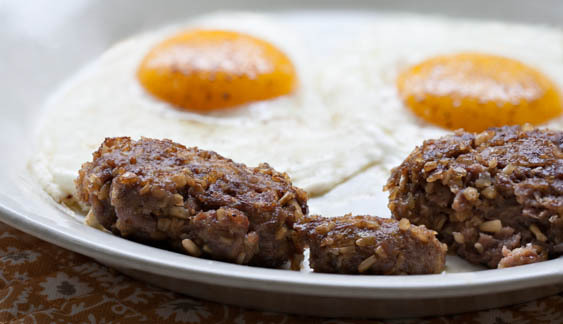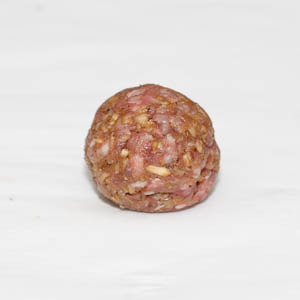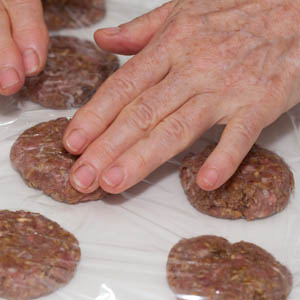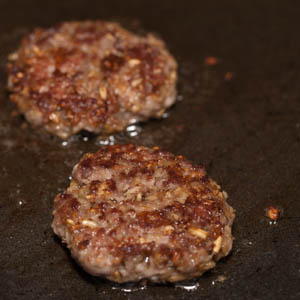Goetta Sausage Patties

introduction
These little patties take their inspiration from Cincinnati’s savory pork and oat sausage called goetta, but their route to breakfast is much swifter—provided you, as we assume, have a functional, well “stocked” larder that includes frozen homemade beef stock, or access to a butcher that sells such an item. If you do, your experience with Anson Mills ingredient requirements will be less complicated. But we digress.
We have grown to love what beef stock and oats do for a sausage forcemeat. Sausage patties don’t typically enjoy the attention of a beautiful glace de viande or small, bias-cut heirloom oats, but absolutely no one is complaining about the interaction. The oats consume their weight in stock during a skillet precook and carry that richness into the ground meat, as well as a fun little bounce and juiciness. The spice mix reflects the relationship of this recipe to its antecedent, goetta, with notes that are peppery and fragrant with shallots and bay.
Cooking Remarks
We use homemade beef stock to put our goetta together because we regard its flavor depth as essential to the real goetta experience. We take a slight departure from our excellent stock recipe by suggesting that the fat and drippings collected in the pan after the bones and vegetables have roasted be poured through a fine-mesh strainer into a bowl and reserved. A couple of teaspoons of these aromatic drippings will be used to fry the goetta—and believe it when we tell you this stuff is delicious!
The herbs in goetta are traditionally dried and dispossessed of any leafiness—as in ground up. For this recipe, dried thyme can be left in leaf form. Sage is easy to find in powdered form. But rosemary, whose presence we prefer to thyme in this mélange, does require a pass through the electric coffee grinder. Begin with more than you need (a couple of tablespoons, or so), grind away, and then winnow the powder through a tea strainer. Spoon into a jar and cover tightly.
equipment mise en place
For this recipe, you will need a digital kitchen scale, a medium heavy-bottomed saucepan, an 8- or 9-inch skillet with a lid, a heatproof rubber spatula, two medium bowls, parchment paper, plastic wrap, a 12-inch nonstick skillet, and a metal spatula.
-
for the stock reduction:
-
12ounces (1½ cups) Good Old-Fashioned Beef Stock, fat reserved from roasting the beef and vegetables; see Cooking Remarks
-
2Turkish bay leaves
-
-
for the seasoning mix:
-
¾teaspoon freshly ground black pepper
-
½teaspoon fine sea salt
-
½teaspoon ground sage
-
Scant ¼ teaspoon ground dried rosemary or thyme (see Cooking Remarks)
-
-
for the sausage:
-
1ounce (3 tablespoons) minced shallots
-
1.5ounces (¼ cup) Anson Mills Handmade Toasted Stone Cut Oats
-
5ounces ground pork
-
5ounces ground beef
-
-
for serving:
-
Fried or scrambled eggs
-
-
Make the stock reduction: Combine the stock and bay leaves in a medium heavy-bottomed saucepan, bring to a simmer over medium heat, and simmer until reduced to 6 ounces (¾ cup) (fig. 1.1). Remove the pan from the heat, cover, and let cool to room temperature (the stock will continue to evaporate as it cools).
-
Make the seasoning mix: Combine the pepper, salt, sage, and rosemary or thyme in a small bowl and stir to combine. Set aside.
-
Make the sausage: Spoon 2 teaspoons of the fat reserved from making the beef stock into an 8- or 9-inch skillet and heat over medium heat until melted. Add the shallots and sauté, stirring constantly, until fragrant and slightly softened, about 2 minutes; take care not to let them color. Off heat, stir in the seasoning mix. Let cool slightly. Measure out 3.8 ounces (scant ½ cup) of the cooled stock reduction and stir it into the skillet. Stir in the oats (fig. 3.1).
-
Return the skillet to the medium-high heat and bring the mixture to a boil, stirring frequently with a heatproof rubber spatula; this should take about 2 minutes. Reduce the heat to medium-low or low (depending on how hot your burner runs) and cover the skillet. Set a timer for 3 minutes. Stir once or twice during that time, replacing the lid as quickly as possible. Remove the skillet from the heat and set a timer for 5 minutes to allow the oats to repose. After the 5 minutes, uncover the skillet and stir the oats. They should have absorbed the stock (fig. 4.1). Transfer them to medium bowl, cover with plastic wrap, and refrigerate until cool, about 20 minutes.
-
While the oat mixture cools, combine the two ground meats in a medium bowl and quickly and thoroughly work them together with your fingers. Cover with plastic wrap and refrigerate until needed.
-
Add the ground meat mixture to the cooled oat mixture and thoroughly combine them with your fingers (fig. 6.1); it’s not going to happen without a little effort. Place a sheet of parchment paper on the work surface. Divide the sausage mixture into fourteen 1.2-ounce pieces. Roll each into a ball between your palms and place them on the parchment (fig. 6.2), spacing them evenly When all the balls have been formed, cover them with a sheet of plastic wrap. Using the palm of your hand, press each ball into a ½-inch-thick patty about 2 inches in diameter (fig. 6.3). The sausage may be fried immediately, or, better yet, refrigerated for up to a day.
-
Place the patties on several thicknesses of paper towels and dry them gently on top and bottom. Heat 2 tablespoons of the reserved fat in a 12-inch nonstick skillet over medium heat until shimmering. Fry the patties until nicely browned on the first sides, 2 to 3 minutes. Using a metal spatula, carefully flip them over (fig. 7.1) and cook until browned on the second sides. Serve hot with fried or scrambled eggs.
-
-
1.1

-
-
-
3.1

-
-
-
4.1

-
-
-
6.1

-
6.2

-
6.3

-
-
-
7.1

-
Step photography by Kathy Rose